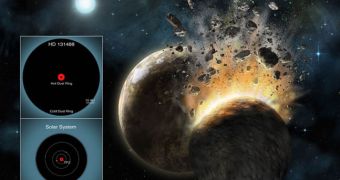Astronomical knowledge has advanced over the years to a point where experts can definitely say that exoplanets can also form around massive stars. The process was initially thought to only be possible around Sun-like types, but that has since been proven wrong. While searching for possibly inhabitable worlds close to our solar system, researchers found a very alien protoplanetary system some 500 light-years away. The dust making up the disk surrounding the star at the center of the system was found to be unlike any others astronomers noticed before, Space reports.
This finding is very important, because it puts astronomers in a very tight spot. They know that protoplanetary disks can only feature a few classes of dust, none of which can be found in the new system. To make matters even more interesting, the team in charge of the investigation also learned that the disks lay inside the terrestrial planet zone, which is an area around the star HD 131488 that is heated to the temperatures found on Earth. In other words, parts of the dust disk around the celestial object are found in its habitable zone. This means that a planet forming there would benefit from the same range of temperatures our own planet does.
Speaking earlier this month at the 215th meeting of the American Astronomical Society (AAS), in Washington DC, experts at the University of California in Los Angeles (UCLA) said that the chemical make-up of the system needed to be determined as soon as possible. “Typically, dust debris around other stars, or our own Sun, is of the olivine, pyroxene, or silica variety – minerals commonly found on Earth. The material orbiting HD 131488 is not one of these dust types. We have yet to identify what species it is – it really appears to be a completely alien type of dust,” expert Carl Melis says. He conducted the new investigation while still a graduate student at UCLA.
Another unusual discovery is the fact that the team discovered both hot and cold dust around the central star. While the warm variety swirls around HD 131488 at a distance comparable to that of the Earth from the Sun, the cold dust revolves around the same celestial body at a distance equivalent to that of the Kuiper Belt from the Sun, or 45 times farther out. “Although dusty telltales of planetary formation processes in the outer regions surrounding young stars have often been seen with infrared-sensitive space telescopes, for some reason stars that have large amounts of orbiting warm dust do not also show evidence for the presence of cold dust. HD 131488 dramatically breaks this pattern,” UCLA astronomer Benjamin Zuckerman explains.
More research is needed into why both types of dust are visible, but experts believe that the dust may have come from two protoplanets colliding with each other. This could help explain the two dust lanes around the star, as well as their spacings and chemical compositions.

 14 DAY TRIAL //
14 DAY TRIAL //